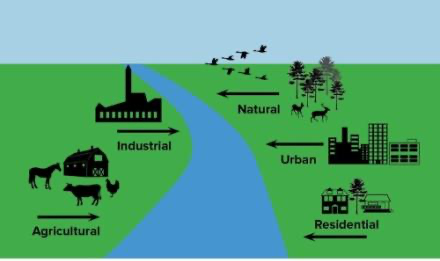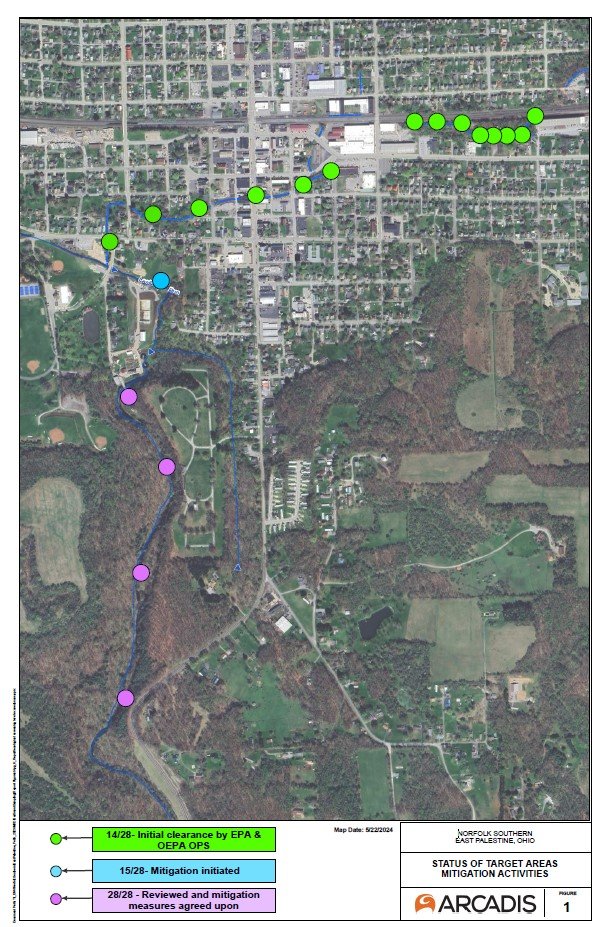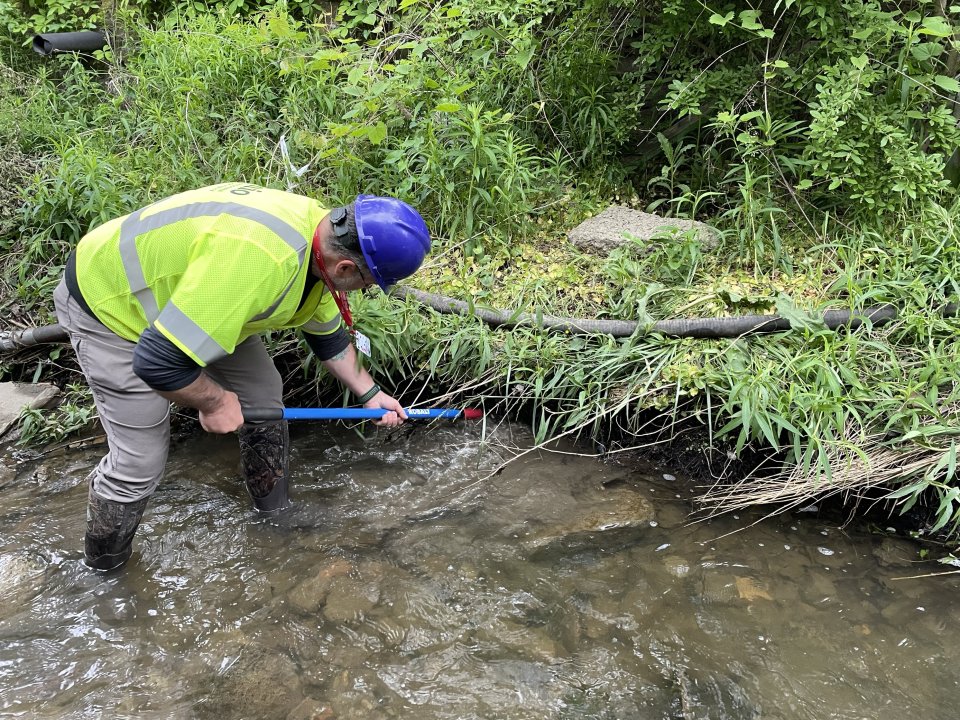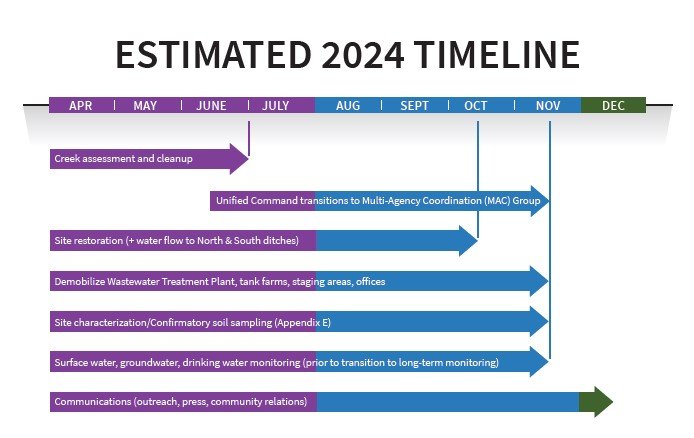Newsletter: East Palestine Train Derailment Response, 5-23-2024
Newsletter serving Serving East Palestine, Negley, Darlington, and surrounding communities
Progress Made
Stream Cleaning Continues
Sediment cleanup is currently underway in Sulphur and Leslie Runs after qualitative assessments done last year found 28 separate stream sections that needed cleanup work (see map, right – note some dots stand for more than one section). All 14 stream sections in Sulphur Run have been cleared and will be evaluated a final time during the full stream assessment phase. Crews have begun work in Leslie Run and will continue cleaning Leslie Run following Memorial Day. In Sulphur Run, large vacuum hoses (see vacuum photo, above), washing hoses, hand tools and higher-pressure hoses were used to disturb and capture oily sheen and sediment. During this work, three areas of containment were established downstream to capture and contain any lingering sheen. Each layer of containment uses boom, oil sheen curtains, and vacuum trucks. Cleaning tactics may differ in some areas of Leslie Run to preserve sensitive aquatic habitats.
Stream Clearing Operations
After crews clean a section of stream, the area is left undisturbed for a period of at least 12 hours. Next, EPA and Ohio EPA assess the area to determine whether the section can move on to the full assessment phase. The assessment is visual and includes disturbing the sediment throughout that section of the stream to check for oily sheen. If sheen is observed and scores larger than a “sheen score 1”, then that area cannot be cleared and requires more cleaning. If oily sheen is not observed, or if only small wisps are seen, then that area moves on to the full assessment phase as shown in the graph on the right. Small amounts of sheen may remain because excessive digging into the stream channel can cause harmful erosion, damaging the creek banks and adjacent properties and negatively impacting sensitive habitats. As of May 23, 14 of the 28 sections have been cleared by EPA and Ohio EPA to move on to the full stream assessment phase.
This schedule is an estimate and is subject to change based on several factors, including without limitation, obtaining required regulatory approvals, access, weather, equipment malfunction, receipt of laboratory results, etc.
Did you know?
Point Source vs. Nonpoint Source Pollution

Photosource: New York State Department of the Enviormental Conservation
Pollution can come from two types of sources, known as “point source” or “nonpoint source.” EPA defines point source pollution as “any single identifiable source of pollutants that are discharged, such as in a pipe, ditch, ship or factory smokestack.” Much of EPA’s work related to the train derailment is cleaning up point source pollution from the damaged train cars. Another source of pollution is “nonpoint source” which can come from many sources like urban areas, agricultural chemicals, or historic industry. Through rainwater runoff, this mix of pollutants can end up in our lakes, rivers and streams. This type of pollution is difficult to control because it comes from many different sources and locations. As stream cleanup continues, it can be difficult to separate these different sources of pollution, but when crews identify sheen through sheen assessments, steps are followed to clean up derailment-related contamination. Additionally, EPA and Ohio EPA programs and initiatives continue to help improve the overall watershed from nonpoint sources.
To learn more on how you can do your part to h help prevent non-point source pollution.
Multi-Agency Coordination (MAC)
Once stream cleanup efforts are completed this summer, EPA and its Unified Command partners will re-organize into a Multi-Agency Coordination, or MAC Group. Unlike the Unified Command structure that has been in place since February 2023, the MAC Group consisting of the same local, state and federal representatives who worked together in Unified Command will coordinate with a separate standard remediation project management structure that is more suited to the final restoration phases of the project. The MAC Group will include EPA, Ohio EPA, Columbiana County Emergency Management Agency, Village of East Palestine, and Norfolk Southern. Public communications will be shared as needed instead of weekly, and we will no longer use a joint information center. There will be no change to field operations. EPA will remain on-site to oversee Norfolk Southern’s work, and the MAC Group will remain until the end of site work. This transition is typical at long-term emergency responses and signifies great progress.
Key Project Update
Final Confirmation Sampling
The areas to the northeast of the derailment site, including adjacent wetlands, were sampled in January and May 2024. This activity was conducted as part of the site-wide final confirmation sampling. If any soil sample is above the screening level, that area will be evaluated to determine if more action is necessary. Overall, confirmation sampling is more than 60% complete but will be paused temporarily while water storage areas are decommissioned so that soils underneath can be sampled. Confirmation sampling is expected to continue until November.





